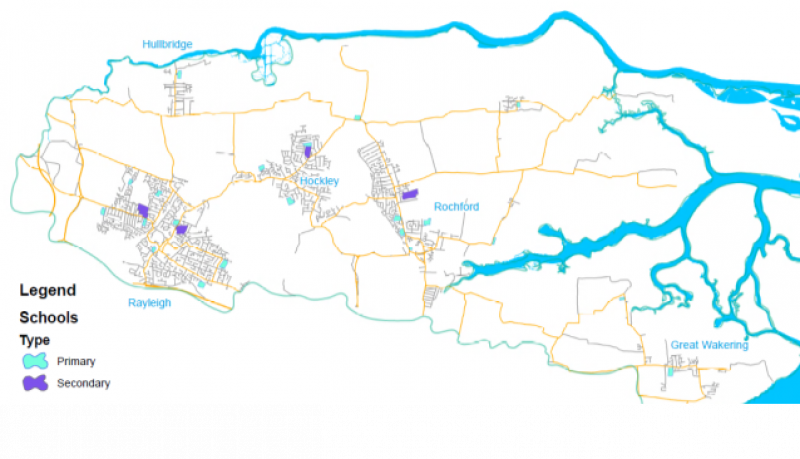New Local Plan: Spatial Options Document 2021
 Community Infrastructure
Community Infrastructure
Relevant Plan Objectives: 9, 14, 18, 19
National policy requires plans to make sufficient provision, through strategic policies, for community facilities (including health, education, and cultural infrastructure). The delivery of new community infrastructure to meet the needs of the local community is crucial to the development of Rochford District as an attractive and healthy place to live and visit, and to meet the needs of future generations. Community infrastructure will need to be delivered in locations that are accessible to both existing communities and future communities, and the Council will need to work closely with the providers of these facilities to ensure there is sufficient capacity.
We recognise from previous engagement with communities, including through the Issues and Options consultation, that many residents feel that the capacity of community infrastructure has not been able to keep up with population growth. It is therefore important that the Plan takes an infrastructure-first approach to planning, ensuring that any projected deficits in provision are addressed. The Council has prepared a joint Infrastructure Position Statement to identify the capacity of current provision.
Education
National policy requires that a sufficient choice of school places is available to meet the needs of existing and new communities. New housing and population increase will inevitably bring an increased demand for school places. The planning and provision of school education is the responsibility of Essex County Council (ECC). However, since the introduction of academies and free schools in 2010, the provision and operation of schools has shifted towards greater levels of institutional autonomy. Academy schools are independent of local authority control, and are instead funded directly by central Government, and sponsors. Free schools have similar levels of autonomy, however, can be set up by a range of groups, including charities, universities, parents, teachers, businesses, and faith groups. Although some schools have extra capacity, there may be need for more places to be made available or for completely new education facilities to be built. ECC publishes school capacity projections as part of its 10 Year Plan for School Places, which identifies some settlements with projected shortages in school places by 2030, including Rochford, Gt. Wakering and Hullbridge.

Figure 33: Map of Key Education Assets
Beyond primary and secondary education, it is also important that the plan makes adequate provision for other forms of education including facilities for early years and childcare, Post-16 and further education, special educational needs and disabilities, and adult community learning. Each of these services may require effective planning to ensure that adequate land and capacity is available to address existing and future demand, either within the District or as part of a wider education network.
Strategic growth locations are likely to require new education facilities (particularly primary education), so the lack of current spare capacity does not restrict areas being considered for growth. However, it may have an impact on the type of growth which is possible – for instance, urban intensification may not allow for sufficient sized sites required for additional education facilities. The Essex County Council Developers' Guide to Infrastructure Contributions highlights that developments with an individual or cumulative size of 1,400 homes are likely to be required to deliver a new two-form entry primary school, whilst developments with an individual or cumulative size of 4,500 homes or more will need to provide a new two-form entry secondary school. One of the most effective ways of addressing educational capacity issues is through the provision of new services funded by development. It is therefore important that new growth is not simply seen as creating additional demand for community infrastructure but also as one of the most effective tools at creating additional supply.
Healthcare Facilities
With a growing and ageing population, provision of health and community facilities and services in the District is going to become even more important. There is a need to provide health care facilities that meet existing and future needs, including those arising from the population growth across the plan period. At this time, Castle Point and Rochford Clinical Commissioning Group (CCG) hosts 28 practices, of which around half are in the District, which have an average practice list of around 8,000 residents, which, whilst lower than the national average, masks difficulties on some communities to access healthcare services as quickly as needed. A growing and ageing population is expected to exacerbate these issues and new models of care are being considered to mitigate these issues.
Future models of healthcare are likely to be less reliant on physically visiting a surgery, although that will remain an option, and a greater move towards online and digital consultations. Physical healthcare centres may also be consolidated into hubs which contain a greater breadth and depth of services. It is therefore important that we create additional capacity for healthcare services through the plan, which may mean the creation of new physical healthcare hubs but also by enabling healthcare services to become more digital by improving the availability of fast connections.
Shifting demographics and models of provision may have implications for the Local Plan, both in terms of ensuring that adequate land is available for healthcare services and in ensuring that the plan as a whole creates healthier outcomes across the population to reduce the need to access healthcare services as far as possible.
Community and Other Facilities
The planning system can also play an important role in ensuring there are sufficient community and youth facilities to serve residents. These spaces are important for public health, networking and nurturing active communities. The plan can play an important role in identifying where there is insufficient access or capacity in existing community and youth facilities and helping to deliver new facilities. This will be particularly important in any large-scale developments which will effectively create new communities and increased demand for hall and facility space.
These other facilities can include:
- Community Centres, Libraries and Halls
- Allotments
- Play Spaces
- Waste and Recycling Centres
The Plan will need to ensure that local communities have adequate access to these facilities, ideally by sustainable modes of transport, and will consider co-locating these facilities where possible. Where new growth is planned, developments that are not well-served by existing facilities will need to make adequate provision for new on-site facilities or make contributions to improving the capacity or accessibility of existing facilities, such as those set out in the Essex Developers' Guide to Infrastructure contributions.
OPTIONS - Non-exclusive options for meeting community infrastructure needs through the plan include:
- Meeting future demand for community infrastructure by protecting existing school and healthcare sites through a specific allocation in the plan that allows for their managed expansion to meet changing demand for services
- Meeting future demand for community infrastructure by identifying sites for the creation of new community infrastructure, where demand exists or will exist, which could include co-located and integrated community buildings funded by planning obligations from new development
- Meeting future demand for community infrastructure by requiring new developments to deliver new community infrastructure on-site where it creates sufficient demand to sustain them
- Helping to address existing shortfalls in community infrastructure access or capacity by improving the availability of existing community facilities to a larger group in the community, such as making school facilities available for public hire subject to reasonable conditions
(151) Q37. Are there areas in the District that you feel have particularly severe capacity or access issues relating to community infrastructure, including schools, healthcare facilities or community facilities? How can we best address these? [Please state reasoning]
